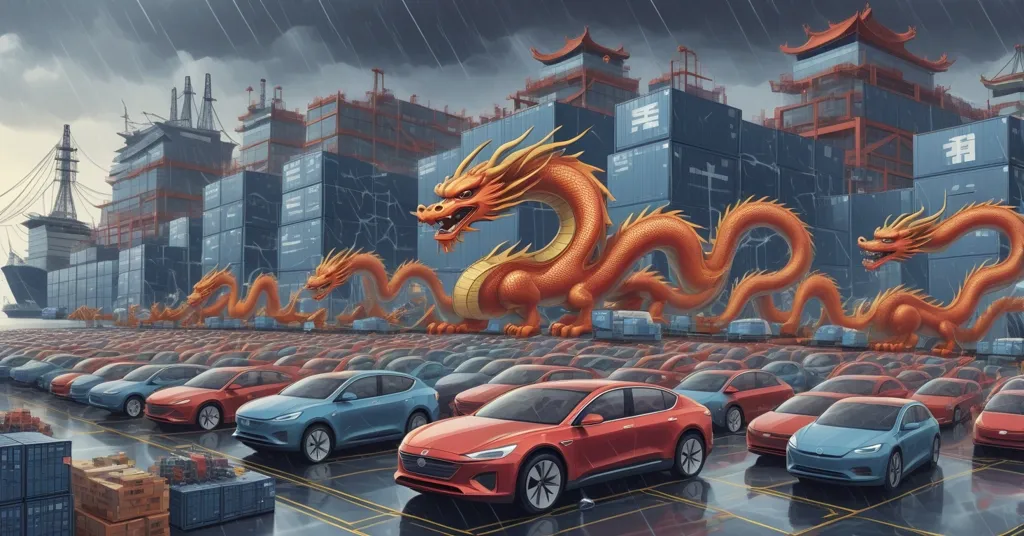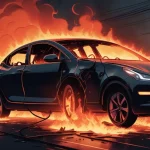BYD Hits Brakes: EV Giant Cuts Production Amid China Chaos and Global Expansion Risks

BYD Slams the Brakes: Chinese EV Titan Reins In Amid Domestic Chaos and Global Gambles
Chinese electric vehicle (EV) behemoth BYD, recently crowned the world’s top EV maker ahead of Tesla, is hitting a wall of unsold cars and cutthroat pricing at home. Now, it’s scaling back its once-relentless expansion while chasing new horizons abroad. Think of it as a high-speed race car forced to downshift—still powerful, but navigating a treacherous turn.
- Production Slash: Night shifts axed at multiple factories, output cut by up to a third.
- Domestic Mess: Inventory balloons, sales growth stalls, dealers buckle under price wars.
- Global Bet: Exports soar in Europe and beyond, seeking profits where China falters.
Domestic Disaster: A Stockpile Nightmare
BYD’s ascent to EV supremacy was nothing short of staggering. Last year, it surpassed Tesla with 4.27 million vehicles sold in 2024, fueled by China’s aggressive subsidies and BYD’s mastery of in-house battery production. Aiming for 5.5 million sales in 2025—a gutsy 30% leap—the company seemed poised to dominate. But reality bit hard. Output growth slowed to a pitiful 13% in April 2024, then flatlined at nearly 0% in May, marking the weakest performance since the Lunar New Year dip. Monthly production in April and May 2025 plummeted 29% compared to Q4 2024. Why? They built too damn many cars, and not enough folks are buying, as detailed in recent reports on BYD’s rapid expansion slowdown.
Dealers across China are choking on inventory, with stock levels at 3.21 months—more than double the industry average of 1.38 months, per the China Automotive Dealer Association. This glut is a cash flow killer. In Shandong province, one dealership chain shuttered 20 outlets, unable to offload vehicles. The China Auto Dealers Chamber of Commerce has been ringing alarm bells, pleading with manufacturers like BYD to stop flooding lots and align production with actual demand. BYD’s response was blunt but pragmatic: night shifts were canned at least four factories, output slashed by up to a third at several plants, and new assembly lines put on hold, according to updates on BYD’s production cuts. It’s a retreat, plain and simple, prioritizing stability over blind ambition.
Let’s zoom out for the uninitiated. China’s the biggest EV market globally, driven by government policies pushing green tech through incentives and sprawling charging networks. EVs, for the unfamiliar, are vehicles powered primarily by electricity, often via lithium-ion batteries, cutting reliance on fossil fuels. But when an economy like China’s slows post-COVID, even hefty subsidies can’t force consumers to buy what they don’t need or can’t afford. BYD’s facing a brutal wake-up call: supply outstripping demand isn’t just bad business—it’s a crisis. For more background on the company, check out BYD’s comprehensive profile.
Price War Hell: Racing to the Bottom
Then there’s the bloodbath of pricing. BYD slashed costs to move units, with entry-level models now at a dirt-cheap 55,800 yuan (roughly $7,800). Hell, that’s less than some Bitcoin mining rigs, but at what cost? Initially, it spiked sales, but now margins are hemorrhaging. Dealers are getting squeezed dry, and the broader Chinese auto market is reeling. Competitors had no choice but to follow, sparking a price war that’s triggered a sell-off in auto stocks and caught the attention of regulators, as explored in this analysis of BYD’s price war impact. Chinese authorities are keeping a hawkish eye, worried this race to the bottom could destabilize suppliers and smaller players.
Price wars aren’t just a marketing stunt in hyper-competitive arenas like China’s EV sector—they’re survival tactics with nasty side effects. BYD’s edge comes from vertical integration, meaning they control most of their supply chain, from batteries to assembly, keeping costs low. But even giants bleed when they cut too deep. The irony? While this brutal pricing might tank profits short-term, there’s a devil’s advocate take: it could turbocharge EV adoption long-term. Much like Bitcoin’s early days saw dirt-cheap transaction fees to lure users, BYD’s rock-bottom prices might hook budget buyers into the electric future. Still, that’s cold comfort for dealers closing shop today. Community discussions on platforms like Reddit highlight BYD’s pricing strategies in the EV space.
Global Gambit: Exporting Hope
With the home front turning sour, BYD’s looking outward. Exports are their lifeline, with 350,000 of the 1.76 million vehicles sold in the first five months of 2025 shipped to Southeast Asia, Europe, and Latin America. Chairman Wang Chuanfu has a bold target: double overseas sales to 800,000 units this year, betting that international markets will eventually outshine domestic returns, as noted in reports on BYD’s international sales goals. In the UK alone, BYD’s sales exploded from 1,611 vehicles through April last year to nearly 12,000 in the same stretch this year. They’ve rolled out the Dolphin Surf model in Rome, priced at a competitive £18,650 in the UK, targeting budget-conscious Europeans hungry for affordable green tech.
But don’t kid yourself—going global isn’t a cakewalk. Geopolitical storms are brewing, with the U.S. and Canada slapping 100% tariffs on Chinese-made EVs under the Trump administration. BYD’s sidestepping these markets for now, opting to assemble locally with Chinese components as a workaround. Then there’s logistics: shipping costs, local assembly laws, and brand perception challenges. How does a Chinese EV stack up against Tesla’s sleek rep in Europe? Not to mention cultural barriers—convincing buyers abroad that BYD isn’t just cheap but reliable takes work. Still, higher margins on overseas sales offer a flicker of hope if they can navigate the minefield. For deeper insights, explore academic analyses of BYD’s global expansion.
Decentralized Dreams: Could Crypto and Blockchain Gear Up BYD?
Now, let’s shift gears to something closer to our beat here at “Let’s Talk, Bitcoin.” BYD isn’t in the crypto game—yet—but imagine the possibilities. With a supply chain as sprawling as theirs, spanning battery production to global assembly, blockchain could be a game-changer for transparency. We’re talking tamper-proof digital ledgers to track battery sourcing and prove compliance with strict environmental rules in places like Europe. BMW and others are already piloting blockchain for similar purposes; why not BYD? It’s not a pipe dream—it’s a practical step toward meeting global standards while cutting compliance costs, as discussed in research on blockchain in EV supply chains.
Then there’s payments. In volatile markets like parts of Latin America, where currencies can tank overnight, crypto like Bitcoin or stablecoins could streamline international sales. Skip the currency controls, ditch the hefty transaction fees, and align with the decentralized ethos we’re all about. Sure, convincing a car giant to adopt crypto isn’t happening tomorrow—let’s be real, corporate inertia is a beast. But in a sector obsessed with disruption, it’s not crazy to think BYD could test these waters, especially if it means faster cash flow from exports. This kind of move would scream “effective accelerationism,” pushing tech boundaries faster than regulators can blink.
Innovation as Survival: Betting on Tech
BYD isn’t just leaning on exports to save the day—they’re doubling down on innovation. They’re bulking up their intelligent software team to 8,000, with plans to roll out advanced driver-assist systems globally by 2026-2027. Even their sub-$10,000 models pack smart tech, a clear signal they’re playing the long game over chasing quick bucks. Their battery prowess is no slouch either—installing 28.476 GWh of capacity in May 2025 alone, a 101.1% jump year-over-year. Analysts at Deutsche Bank note that while price cuts juice volume, they’re a gut punch to near-term profits. Yet, if BYD can sustain tech leadership and cash in on higher overseas margins, there’s light at the tunnel’s end. For perspectives on their domestic challenges, see discussions on BYD’s market hurdles.
Lessons from Disruption: A Crypto Parallel
Zooming out, BYD’s stumble is a mirror to messes we’ve seen in our crypto space. Think altcoin pumps that crash when hype outruns utility, or Bitcoin’s own scaling wars where ambition clashed with reality. Disruption is a sloppy beast—dominance today doesn’t guarantee tomorrow. BYD’s pivot from reckless growth to calculated sustainability is a hard lesson in balancing innovation with market truths. They’re up against fierce rivals like XPeng, Nio, and even Xiaomi in a fractured Chinese market, all while juggling global risks. If giants like BYD can trip, what does that mean for blockchain startups chasing scale without a safety net? Chew on that one.
Key Takeaways and Burning Questions
- What’s dragging BYD down in China?
A toxic combo of overproduction, with dealer inventory at over three months, and a savage price war gutting margins has forced production cuts and a rethink of lofty sales goals. - Why the hard push into global markets?
Domestic sales are stalling, so exports to Southeast Asia, Europe, and Latin America—where growth booms, like in the UK—offer juicier margins and a buffer against losses at home. - How does a price war screw even a titan like BYD?
Dropping prices to $7,800 per vehicle spikes short-term sales but shreds profits, crushes dealers, and risks destabilizing China’s EV sector, drawing regulatory heat. - Could blockchain or crypto rev up BYD’s future?
Blockchain could lock in supply chain transparency for global compliance, while crypto payments might ease cross-border deals in shaky markets—disruption meeting disruption. - Is BYD’s pullback weakness or calculated genius?
It’s genius with grit—scaling back to match demand and prioritizing innovation and exports shows adaptability, much like Bitcoin weathering storms to stay king.



